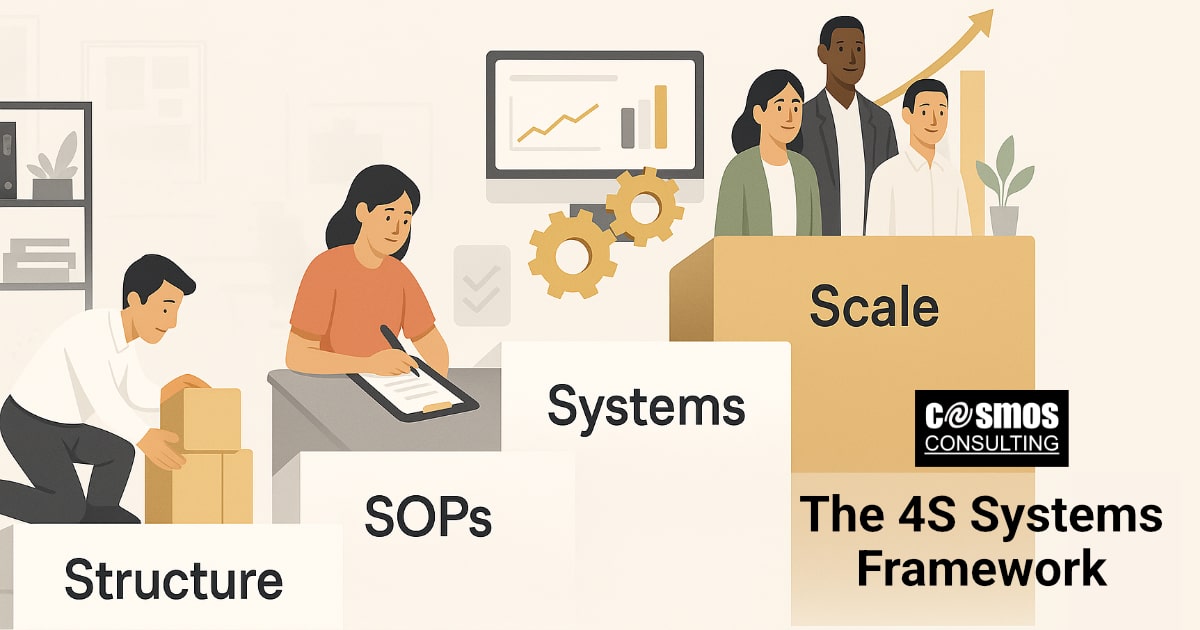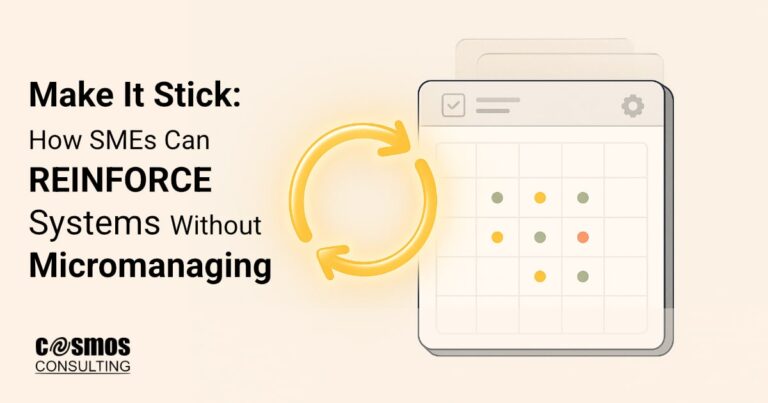🧭 Introduction: Scaling Is not the Problem; Chaos Is
Every founder asks the same question: how to scale an SME without chaos? The answer lies in building scalable systems for small businesses – simple structures that grow with you, even when you are not watching. You don’t need complex software to run a well-oiled operation.
Most small businesses hit a growth ceiling not because they lack effort or demand, but because their operations aren’t built to scale. Everyone is hustling. No one can explain how things really work. And when key people go on leave, everything stalls.
That is where Cosmos Consulting’s COSMOS 4S SME Systems Framework™ comes in.

Define roles, workflows, and tools
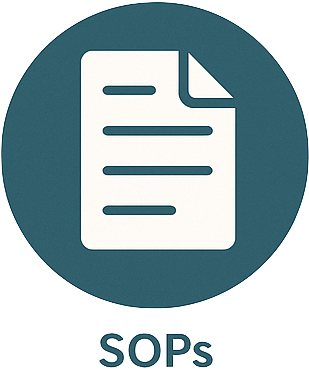
Document how work gets done
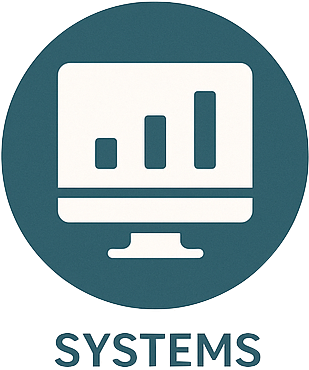
Build tech, templates, or automations
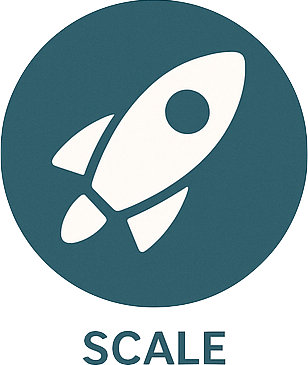
Delegate with clarity and track performance
Developed from decades of on-ground operations experience, the 4S Framework is our blueprint for building chaos-free, scalable operations, starting with just one SOP.
📌 “Systemising is not a luxury. It is your only path to scaling without burnout.”
It is not another tool or off-the-shelf system. It is a method designed for SMEs who want leaner processes, clearer workflows, and teams that execute without daily firefighting.
And when those systems are in place, but the leader still is the bottleneck, that is where our COSMOS 5R SME Leadership Framework™ takes over.
One builds the foundation. The other ensures it scales without depending on you.
🧠 How to Scale an SME using the COSMOS 4S Systems Framework™?
The COSMOS 4S SME Systems Framework™ is Cosmos Consulting’s signature method for designing scalable systems for small businesses operating with lean teams, built for the way SMEs work.
It is based on a simple truth: you can’t scale what is invisible.
Most growing businesses don’t fail because of a lack of demand; they stall because daily operations are held together by habit, memory, or one overworked founder trying to do it all.
The 4S Framework gives you a structured, practical roadmap to move out of chaos and shows you how to scale an SME step by step. It helps you:
- Define how things should run – Structure
- Document the core tasks once – SOPs
- Build simple systems for visibility – Systems
- Delegate with clarity and track performance – Scale
With 4S, you don’t need more tools or more people, just clarity, consistency, and the right method.
🎯 If you have been asking yourself how to scale an SME, start with the 4S Checklist.

🏗️ Step 1: Structure – Stop Being the System, get ready for Scale
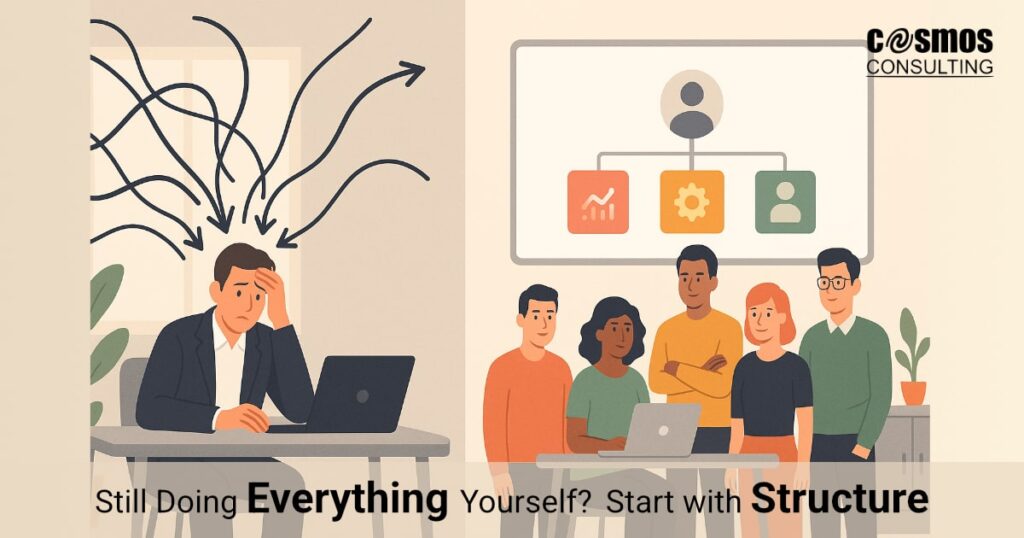
The first step in how to scale an SME is to stop letting your business run on memory and assumptions.
In most SMEs, the founder is the system, the one who remembers how everything works, who follows up with everyone, and who unblocks every decision.
But that model doesn’t scale. Not for you. Not for your team.
That is why STRUCTURE is the foundation of the 4S Framework.
Before you create SOPs or adopt tools, you need to define who owns what, clearly and in writing. You need to map roles, responsibilities, and routines in a way that removes confusion and builds ownership.
This step is where most systems fall apart. But it is also where transformation begins, and this is why it is considered the foundation of building scalable systems for small businesses.
🟡 For example: In one manufacturing SME, the warehouse team handled logistics, but so did the sales team, and so did the admin staff. No one had clear boundaries. Deliveries were delayed, and everyone blamed each other.
Once the task ownership was mapped and a visual structure created, things changed fast, roles became clear, decisions were faster, and chaos dropped overnight.
👉 Read the deep dive: Still Doing Everything Yourself? Start with Structure
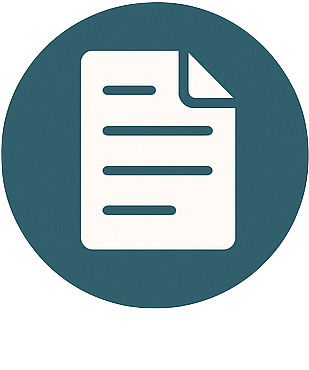
📄 Step 2: SOPs – Document Once, Decide Less. How to Scale an SME Using SOPs?

Once roles and responsibilities are clearly defined, the next step in how to scale an SME is to document how key tasks are actually done.
SOPs (Standard Operating Procedures) are often misunderstood, especially by lean teams who feel too busy to write things down. But the right SOP is not paperwork – it is a decision-saving tool.
This ‘S’ earned its place in the framework because too many SME teams rely on memory, verbal instructions, or WhatsApp chats to run daily operations. That leads to missed steps, repeated questions, and preventable mistakes.
A well-written SOP answers recurring questions on how to scale an SME once, so they don’t get asked ten more times. It reduces guesswork, builds confidence, and frees up the founder’s time..
🟡 Example: In many small businesses, billing is handled by admin staff. But what happens when that person is on leave, or the customer has special terms? Without a written process, either the work gets delayed, or the founder is pulled back in. With a simple, 2-step SOP, that loop can be closed for good.
And because you have already clarified who owns what in Step 1, SOPs now have a place to land. They are no longer generic. They are embedded in real roles and routines.
👉 Read the deep dive: SOPs Are Boring? Think Again. They Could Save Your Business

📊 Step 3: Systems – Visibility Without Micromanaging. The Secret to How to Scale an SME

Once structure and SOPs are in place, the next challenge in how to scale an SME is visibility.
Can you see what is happening across your business, without asking ten people or digging through message threads?
This ‘S’ earned its place in the 4S Framework because many SME founders stay stuck in day-to-day oversight simply because there is no system for reporting, tracking, or follow-up. Everything runs, but nothing is visible.
Systems don’t have to be complex. In most cases, a shared tracker, dashboard, or weekly review rhythm is enough to build accountability and uncover delays early.
🟡 Example: In one business, order dispatches were regularly delayed, not because of workload, but because there was no single view of pending vs. packed orders. Once a simple daily checklist was introduced, on-time dispatch rates improved within a week.
Visibility is not about control. It is about freeing up the founder by making information accessible, so the team can take ownership, and the business doesn’t grind to a halt when someone’s offline.
And research from SCORE highlights that effective operations systems “cut costs, deliver better service… and scale your operations more effectively,” exactly what the 4S Framework helps you achieve.
👉 Read the deep dive: Dashboards Don’t Have to Be Ugly — Systems That Make Teams Self-Manage

🔁 Step 4: Scale – Reinforce What Works to help your SME Grow

Scaling is not just about growth; it is about letting go without things falling apart.
This ‘S’ earned its place in the 4S Framework of building scalable systems for small businesses because so many SME founders struggle to delegate, not because they don’t want to, but because they don’t trust the follow-through. And usually, they are right: without structure, SOPs, or systems, delegation becomes just guesswork.
But once the first three steps are in place, you can delegate with clarity, and then track performance without chasing people down.
The COSMOS 4S Systems Framework™ is specifically designed to empower small and medium enterprises to scale effectively while maintaining order and efficiency. By providing a structured approach, it allows founders to instill confidence in their teams, enabling them to take ownership of their responsibilities. This not only mitigates the risk of operational disruptions due to absences but also fosters a culture of accountability and collaboration. Furthermore, as highlighted by SCORE, robust operational systems lead to significant reductions in costs, improved service delivery, and enhanced scalability. Ultimately, the 4S Framework equips SMEs with the tools necessary to navigate growth smoothly, ensuring that the journey towards expansion is not marred by chaos, burnout, or bottlenecks.
🟡 Example: A client-facing role might be assigned to your sales lead. The SOP defines how follow-ups are handled, and a weekly dashboard tracks conversions. Now you are no longer asking, “Did this happen?” You are reviewing the numbers and guiding improvement.
That is how scaling works in lean teams: less doing, more reviewing, with trust built into the system.
👉 Read the deep dive: You’re Not Scaling if You’re Still the System: The Final “S” Most SMEs Miss
🧩 Why the COSMOS 4S Framework Works in building Scalable Systems for Small Business
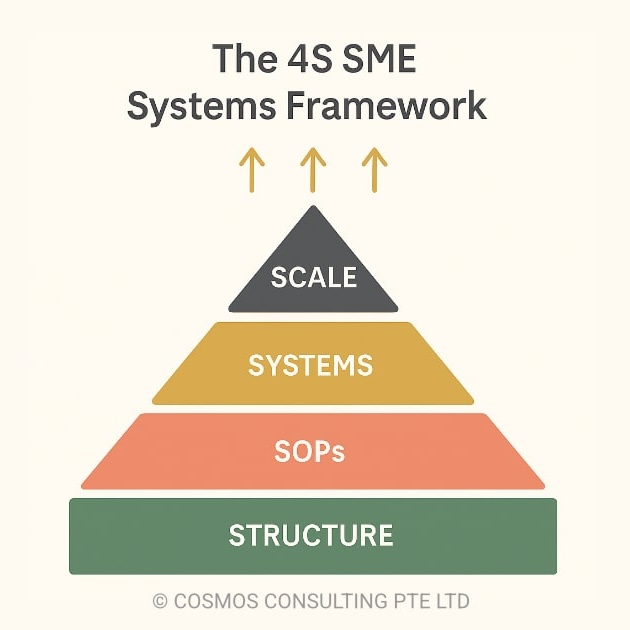
he COSMOS 4S Framework works because it reflects how small businesses actually grow — messily, resourcefully, and often without formal systems — and then answers the core question: how to scale an SME.
It was not designed in a boardroom. It was built by Cosmos Consulting after decades of hands-on work inside SMEs, observing what breaks, what scales, and what gets ignored until it’s too late.
Each “S” was chosen deliberately, not as a buzzword, but because it solves a real operational pain point.
These are not generic steps. They are the minimum viable structure a small business needs to run without chaos.
- Structure brings clarity to roles
- SOPs reduce decision fatigue
- Systems make progress visible
- Scale enables team-led execution
And the sequence matters. When applied in order, the 4S method doesn’t just fix operations – it shows you how to scale an SME with less stress, less waste, and less dependence on the founder.
❓FAQ: COSMOS 4S SME Systems Framework™
Here are some of the most common questions SME leaders ask when trying to build scalable systems using the 4S Framework.
💡 Reflective Takeaway
You don’t need a massive team or a fancy ERP system in your quest to scale your SME.
You need structure.
You need clarity.
You need systems that work when you are not watching.
The COSMOS 4S Systems Framework is designed for exactly that: a simple, strategic path from chaos to clarity, built for lean teams who want to scale without burning out.
If you have been stuck in the weeds or running things from memory, this is your sign to step back and systemise: one SOP, one structure, one system at a time, hence building scalable systems for small businesses.
📥 Want to apply what you just read?
Start by mapping just one role in your business.
Write down what they are responsible for, where they get stuck, and which tasks they handle that no one else fully understands.
You will be surprised by how much clarity that single exercise can create.
✅ If you have been wondering how to scale an SME, the first step is clarity. Download the COSMOS 4S Systems Framework™ Checklist, a free, practical tool to help you spot the gaps in your structure, SOPs, systems, and scalability.
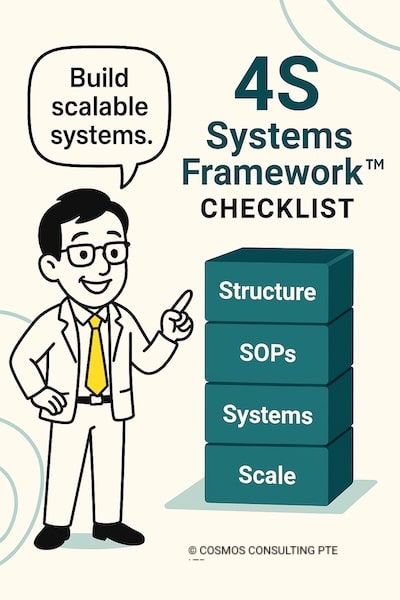
4S Checklist
💡 We use MailerLite to power our lead magnets and client communications. It’s beginner-friendly, powerful, and highly affordable for SMEs
Build smart systems. Lead with clarity. Scale without chaos.
📩 Call to Action
What part of your operations feels the most chaotic right now?
Drop a comment below or write to me, or share which “S” you’re planning to start with to build scalable systems for small business of yours.
Your insights might help another SME leader take their first step too.
🛡 Trademark Notice
The COSMOS 4S Systems Framework™ and COSMOS 5R Leadership Framework™ are proprietary tools developed by Chhavi Jain, Director, Cosmos Consulting. These frameworks are unregistered trademarks (™) and may not be copied, reproduced, or repurposed without explicit written permission.
© Cosmos Consulting, 2025. All rights reserved.

